Tuesday 28 January to Sunday 2 February 2014, Perth
Pieter went for his medical exam in Perth and had his visa extended.
Now we could head north going up the coast road. All along the coast to Two Rocks houses are being built and land sold in complexes. They all tout the pleasure of the coastal life. Large shops are there or also under development. Soon the Perth greater area will extend about 100k up the coast. It already extends south past Rockhampton.
We spent the night beside a soft sand track that necessitated lowering the tyre pressure. Next morning when we tried the compressor it didn’t work. Pieter tried everything and eventually went to the road to ask for help. Reno came along in his Land Cruiser with a small compressor on board and inflated the tyres part way. But it was a slow job and he suggested we follow him to his house down the road near Two Rocks where he had a bigger compressor. He also offered to sell us some tyres.
Anyway it was back to Perth to purchase an X Black compressor with a 5 year guarantee. Pieter also decided that since we would need some tyres soon we should take up Reno’s offer.
Back at his place the deal was finalised and while the men worked I patted the 21 year old Western Grey Kangaroo. This had been given to Gail (Reno’s wife) by her mother as she was no longer able to care for it. The Kangaroo had been taken from it’s dead mother. It is just over a metre high. I was under the impression that all kangaroos were tall. Apparently it is only the Big Reds that go over 7 foot.
The highway north allowed us to move fast for a while. We didn’t see many road trains. They are limited to 53 metres in length. This is a tractor (cabin / engine section) and 4 long trailers.
Monday 3 to Wednesday 5 February 2014, Cervantes
Cervantes is a nice village with 2 attractions, Lake Thetis and the Pinnacles NP.
Lake Thetis is famous for its stromolites. These are a modern version of Earth’s earliest life forms which produced oxygen allowing other life forms to evolve. Stromolites are formed when cyanobacteria bind calcium carbonate. To do this they require very salty water. Lake Thetis is 1.5 times as salty as the ocean which helps to keep predators at bay. The different forms of the stromolites are due to different cyanobacteria. Growth is active when the stromolites are wet, dark areas are wet active growth. There isn’t a whole lot to see but it is interesting.
The Pinnacles, on the other hand are interesting. They are hard rock like structures sticking out of the sand and present an intriguing sight. They are not very large, 3 metres max. There is no consensus on how they were constructed except the two current theories involve plants. Walking around them was fun.
It is getting HOT! We are down to a sheet at night and no longer have tea or coffee. When Pieter is cooking the car is like an oven. It can be up to 44 degrees Celcius.
Thursday 6 to Saturday 8 February 2014, Kalbarri
Near Greenough we caught sight of their horizontal trees. The wind is so strong trees have trouble growing upright. They survive though. We passed through Geraldton which is supposed to be the largest town until Broome. I think Carnarvon and Karratha have taken over this designation. Geraldton had a reasonable supermarket and not much else. The Pink Lake (Hutt Lagoon) at Port Gregory was all it was supposed to be. The pink colour is caused by a bacteria, Dunaliella salina, trapped in the salt granules and provides a source for beta carotene. The beta carotene is mined for health products.
The coast is rugged with almost sheer cliffs. We spent time at one lookout watching small sharks and manta rays feeding close to the shore. Unfortunately the Kalbarri NP was closed for a few days. Instead we had a lovely dinner of a crayfish which we shared. As you can see Pieter couldn’t wait to start!
Sunday 9 to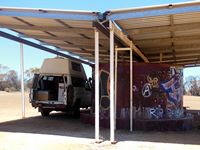 Tuesday 11 January 2014, Monkey Mia
Tuesday 11 January 2014, Monkey Mia
The road to Monkey Mia was interesting. There are several water points along the main road between Carnarvon and Geraldton. These were put in place in the 1930s for travellers along the track as it was then. They saved several lives when the cars broke down and had to be repaired on the go. Since other travellers were few the drivers had to rely on themselves. Tough lot!
Hamelin Pool is the largest site for stromolites in the world. They are slightly
different to the ones at Lake Thetis, much taller and definitely more prolific. There
were also fossilized stromatolites -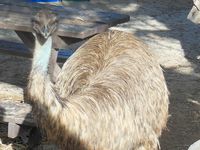 materials available locally.
materials available locally.
Monkey Mia was magic. Not only was there plenty of shade but emus roamed around and the dolphins are fed every morning. Around 8:00 am people line up along the shore while a ranger talks about the dolphins. Gradually the dolphins arrive. Only females are fed so males are not frequent visitors. Again only 5 dolphins are fed and they know who they are! Once the people leave the water they line up for their fish. There are 5 volunteers with a bucket of fish each. Each volunteer is assigned a dolphin as the number of fish differs. The volunteers then ask someone to come forward and feed a fish to the dolphin. It was lovely to watch, everyone truly enjoyed the feeding. The second day we were there Pieter also came and was ready with his camera when I was asked to feed a dolphin. The big grin on my face says it all.
The pelicans also get some fish to prevent them from taking from the dolphins. Dolphins get 12% of their daily food requirement so they still have to fish and thereby teach babies to fish.
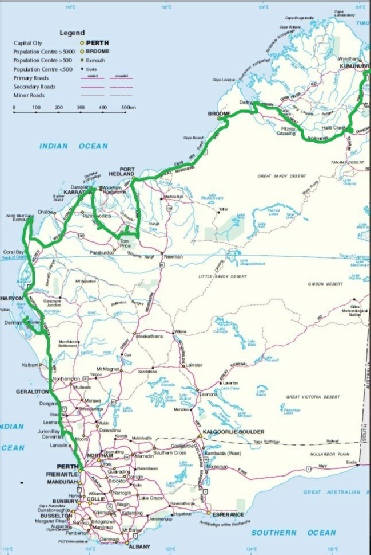
Wednesday 12 to Monday 17 February 2014, Coral Bay and Exmouth
Ningaloo Reef extends along the coast from Red Bluff to the North West Cape just north of Exmouth. It comes very close to shore at times. Coral Bay is one of the most popular places to swim and snorkel. We hired the equipment and gave it a try. Unfortunately we aren’t fit. Pieter had to give up early but I kept going for a while. I did manage to get to the inner edge of the reef and swam along for a while. It was very hard work and I didn’t see anything worth while. Maybe we should have tried going out on a kayak or a glassed bottom boat!
The drive along the shore to Exmouth was not very interesting at all. Sand, dirt, green shrubs, green grasses, termite mounds, two emus and most interesting, kangaroos. Of course if you like swimming and snorkelling there are plenty of opportunities. It is also a good place just to relax.
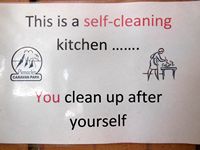
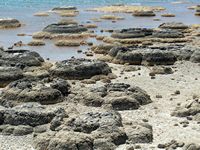
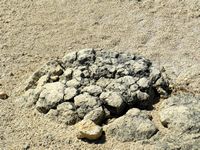
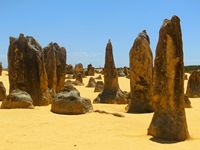
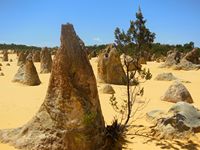
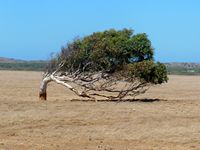
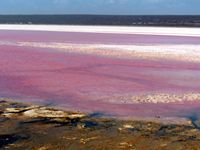
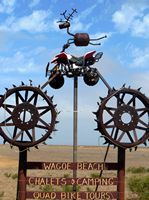
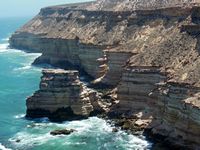
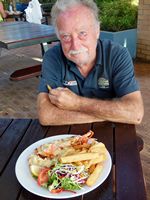
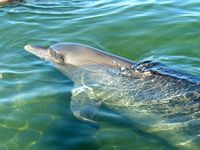
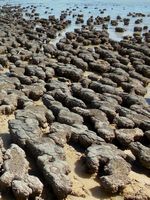
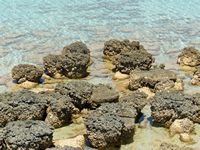
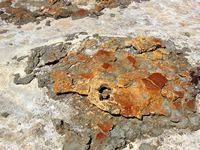
Tuesday 18 to Sunday 23 February 2014, Pilbara
The green vegetation continues. Obviously there has been quite some rain, after all it is the rainy season.
In Karratha we asked about conditions in the Kimberly and if it would not be better to head east to Alice Springs. The Kimberly is wet but main roads are open including the Gibbs River Road. There was a cyclone recently which went from around Broome south east through Alice Springs down to Tasmania. There is little if no water or fuel available going east to Alice Springs and for the next 6 to 8 weeks you are likely to get bogged with no hope of getting any help. Guess it will be the Kimberly.
But first the Pilbara.
We obtained our permit for the Rio Tinto Access Road and headed south east along the iron ore railway. The ore trains are quite impressive. They take around 3 minutes to pass. I think the ones in Mauritania are twice as long but there are fewer than here and they go downhill all the way to the sea.
At the Millstream NP we headed west for a place called Gregory. This is a camping spot on the Fortescue River. I found out about it from a booklet called ‘Explore the Pilbara in your 4WD’. We used another book in the series in the South West. Of course things have changed since the book was published in 2006. The route they describe passing the NP has been closed off. We ended up going on an official route through the NP and then following the water pipeline until we caught up with the original route. The route includes fording the Fortescue river. It was a very bumpy ride with a large rock to get over on the other side. I was expecting lots more shade under the giant Cajuput trees than we had. It was a bit sparse during the day. At least it was lovely to soak in the river and wash away the accumulation of salt and sweat on our bodies. I also took the opportunity to cut my hair. Lots of water to wash it in afterwards.
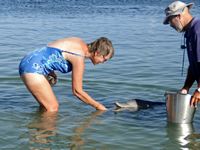
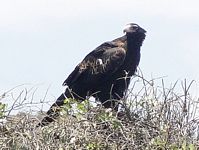
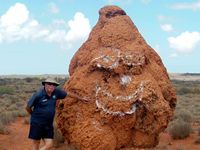
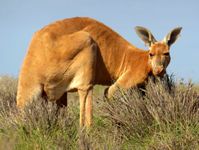
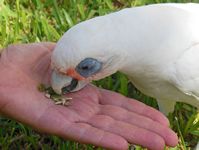
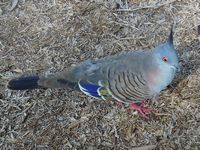
Karijini NP is very impressive. It is part of the Hamersley Ranges where there are rivers and canyons cutting through the ore rich rock. There are lookouts for us oldies and walking trails for the fit and those who can take the heat. The Visitors Centre is very well set out. It covers the history of the area, the geology and the traditions of the aborigines. One thing I did learn is that the red rock is mainly silica, it is the grey rock that is mainly iron. The red rock must have a reasonable level of iron though because it is crushed red rock that is sent to the ports.
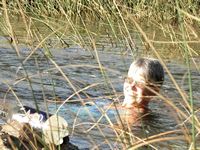
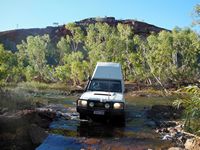
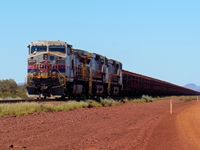
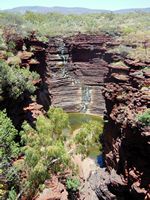
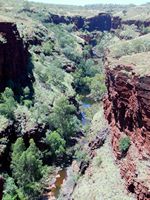
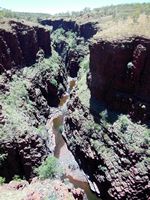
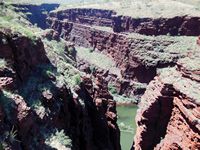
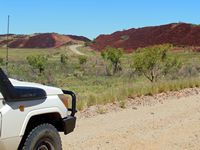
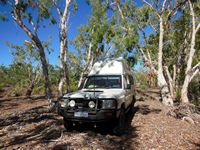
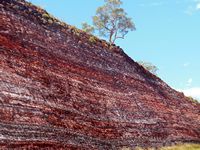
Monday 24 February to Thursday 6 March 2014, Broome
Have I mentioned it is hot, up to 45 degrees? Well it is. We no longer use a top
sheet and when I turnover at night I must first un-
We spent so much time in Broome because my tooth which had broken and been filled in Holland was extremely painful. The dentist in Broome treated the main root canal and replaced the filling he had removed. It still doesn’t feel perfect but maybe the nerves will die soon. Apparently the other two nerve canals are almost completely calcified. We will see.
Friday 7 to T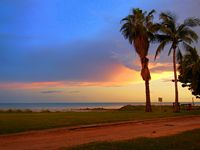 hursday 13 March 2014, Kununurra
hursday 13 March 2014, Kununurra
Unfortunately the Gibb River Road is closed from Mt Barnett to the turnoff to Kalumburu. The road to Kalumburu is also closed. So now we have to go via the main highway. At least I have been told that this is the prettiest time of the year to travel along the highway. We are definitely aware that it is the rainy season. There is a small shower every day. Finally I took a photo of a sunset.
We travelled to Derby which has the highest tidal range in Australia at up to 11.8 metres and one of the highest in the world This creates the horizontal falls which occur when high tide pushes through a narrow passage between two headlands. The best way to see it is on a flight and boat trip through the passage. Being the wet season the flights were not operating!
Of course we stopped off at the boab tree that was used as a temporary prison before transferring the prisoners to Derby. Boab is thought to be a shortened version of baobab as it is a species of this tree.
From Derby we went along the Gibb River Road for a short distance and then took the road past Windjana Gorge and Tunnel Creek National Parks to Fitzroy Crossing. The scenery is lush, lots of trees including boabs and green grass. The road was reasonable most of the time except when there was water over it. The 4x4 was definitely needed to plough through those patches.
The highway to Halls Creek wasn’t too bad, just not very interesting. We spent the night at Caroline Pool which was fabulous. Lots of trees and shade. The river bottom was quite muddy though, not great for swimming.
Near Kununurra it started becoming more hilly, nice for a change as the rest of the road was basically flat for 500k.
We stayed in a campground for a few days in Kununurra to rest. One of the permanent campers, Mark, offered to take us to some local pools. I took up his offer but Pieter stayed behind. It was a lovely outing. First we, Mark, myself and 2 girls, went to Black Rock where water was still flowing down. Next was Middle Springs. Here we climbed up to the top where we swam and relaxed. Some of the pools are quite shallow but one was definitely over 2 metres deep.Both pools retain water through the dry season. Mark had been out there 2 days previously and he said the volume of running water was notably less.
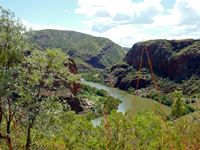
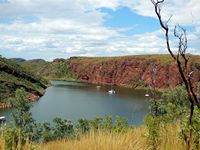
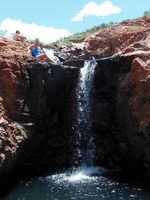
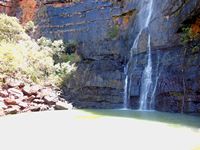
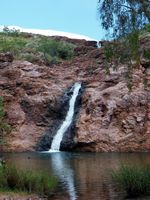
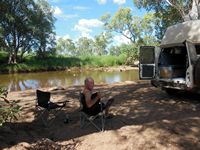
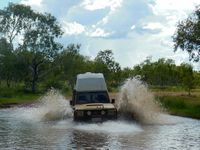
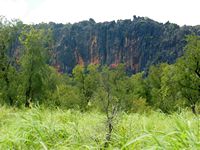
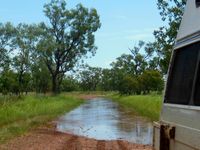
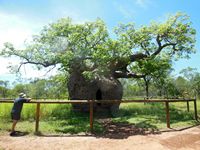
|
Averages |
Australian Dollars |
|
Cost of diesel per litre |
1.75 |
|
Cost of Camping per night |
32.24 |
|
Cost of Hotels per night |
|
|
Daily expenditure |
58.21 |
|
Totals |
|
|
Kilometers travelled |
7,223 |
|
Days in the north |
67 |
Friday 14 to March 2014, Darwin
The drive to Darwin is quite hilly making it slightly more interesting.
Once in Darwin we set about selling the car. First we advertised in GumTree. The replies were all the same.
1. The buyer can’t come and see the car, we can’t deliver the car to them, they will send an agent to pick it up.
2. Payment will be by PayPal. It is easy and secure go to www.paypal.com.au. They can’t pay through the bank because they do not have online banking.
3. If you agree, the money will be sent by to PayPal plus the money for the agent. Unfortunately the agent will only accept Western Union money transfers which the buyer can’t make.
4. Confirmation of the deposit is sent to you. PLUS an e-
We did get as far as this with one potential buyer except for paying the agent’s fee. That was way too fishy.
Needless to say we refused the offers. Come on -
So our plans changed. With no genuine buyers we have now decided to keep the car.
We will return to Europe, sell our European Troopie there (doesn’t that sound grand)
and obtain an expensive permanent visa for Pieter for Australia. Next will be South
Africa to see Pieter-
As for our stay in Darwin, after 4 days free camping around the city we decided to
go to a campground. We were given a lovely shaded spot right near the pool. All that
water to cool off in. Bliss! It is very humid though. A little physical effort and
you start dripping. Even so, once we decided to keep the car I started on a cleaning
spree. It helped that I was bored with reading and doing puzzles! And I didn’t over-


